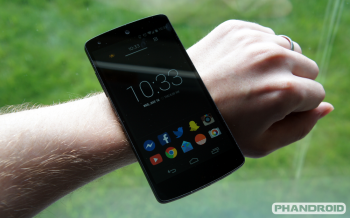
It’s time to stop treating Android Wear like a phone
Android community, we need to talk.
There are a lot of awesome Android developers/hackers out there. They do amazing things that I can’t even dream of doing. Need Android on an old Windows Mobile phone? Done. How about a WebOS device? Piece of cake. Flappy Bird on my smartwatch? No problem. These projects, and many others like them, were done because they could be done. If there is one thing that Android hackers love to do it’s pushing the limits. That is not always a good thing.
Android Wear is the newest member of the Android family. At Google I/O thousands of developers got their hands on the first devices, and last week they shipped to everyone else. Almost immediately we started seeing apps for Android Wear pop up in the Play Store. It started with apps from brand names adding Wear support, but recently we’ve been seeing a new breed of apps developed specifically for your watch.
Many of these new Android Wear apps are completely missing the point of what Google intended for Wear. I’m certainly not the first person to bring this up, but it has been on my mind ever since I mentioned it on the Mobile Roar Podcast last week. Android developers and hackers are once again pushing the limits of what these devices can do, and it could have major ramifications for the future of the Android Wear platform.
The second I saw someone make an app launcher for Android Wear I knew something was wrong. The fact that users were so excited to see this app made me realize it even more. Launching apps is purposefully tedious because it’s not supposed to be a common action. Android Wear is all about getting things done quickly with your voice or simple swipes. Heavy app usage is meant for your phone. This is not just my opinion, either. Google has clearly outlined how they want Wear apps to work.
In Google’s official guideline video for designing for Android Wear you can hear the presenter say “inputs requiring fine-grained motor skills are avoided.” Many of the current Android Wear apps are guilty of violating this. Apps like calculators and keyboards have no place on a tiny watch display. Some of you may ask “but why does Google get to decide how I use my smartwatch?”
The Android ecosystem is no stranger to smartwatches. Samsung has created several smartwatches that run Android, but none of them have done particularly well. Using one of Samsung’s Galaxy Gear devices is like using a tiny version of your phone on your wrist. Some of them even have a camera. Most critics of these devices point to that very reason as to why they’ve failed. A smartwatch is not supposed to be treated like a phone, but that is exactly what’s happening to Android Wear.
Which leads us to the reason why you should trust Google to tell you how to use Android Wear. They have a clear vision for this platform to be something more than just apps. Google is trying to do something valuable with wearables. They don’t just want to slap Android on your wrist and be done with it. However, if users are clamoring for apps like the launcher or widgets, and not giving Wear a chance to be something unique, it could determine the direction Google takes the platform. At the end of the day Google wants users.
The future of Android Wear is in our hands (and on our wrists). Many of the limitations of Wear are there for a reason. These devices are companions, not replacements. There is a reason you see the “Launch on phone” button so often throughout the UI. If you can’t perform the action with a few taps or voice commands it should be done with your phone. This is hard for people to realize, especially when you have a shiny new toy to play with. Embrace a new and different experience. Embrace using your voice. Let’s make Android Wear great.
What do you think?
Whether you have an Android Wear device or not we want to hear your opinion. Should Android Wear apps be shrunken down versions of phone apps? Do you want your watch to have the same functionality as your phone? What should an Android Wear app do for you?